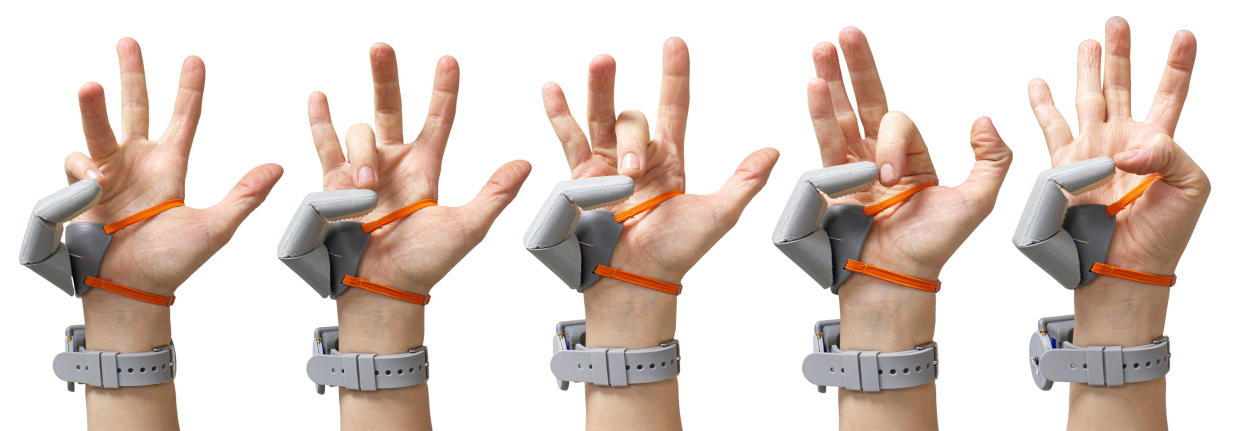Would you like a third thumb? Scientists create robotic prosthetic in world first
Watch: Scientists create 'third thumb' in robot prosthetic world first
It sounds like a sci-fi plot, but a world first could pave the way for cyborg-like additions to our bodies in the future.
British scientists found that using a prosthetic 'third thumb' can force the brain to adapt, allowing the wearer to use it to complete tasks like building a tower of blocks blindfolded, completely naturally.
In a study, scientists attached an extra robotic thumb below participants' pinky finger then took MRI scans of the wearers' brains and found they had adapted to accommodate using the extra thumb.
The findings are believed to be a first step towards augmenting our bodies using prosthetics – akin to the cyborgs of science fiction – in the future.

The project was the work of researchers from the University College London (UCL) Institute of Cognitive Neuroscience and designer Dani Clode, who began developing the device, called the Third Thumb, as part of a graduate project at the Royal College of Art.
Professor Tamar Makin, lead author of the study, said: "Body augmentation is a growing field aimed at extending our physical abilities, yet we lack a clear understanding of how our brains can adapt to it.
"By studying people using Dani's cleverly-designed Third Thumb, we sought to answer key questions around whether the human brain can support an extra body part, and how the technology might impact our brain."
Read more: UK 'could be at start of third COVID wave due to Indian variant'
First author of the study, Paulina Kieliba added: "Body augmentation could one day be valuable to society in numerous ways, such as enabling a surgeon to get by without an assistant, or a factory worker to work more efficiently.
"This line of work could revolutionise the concept of prosthetics, and it could help someone who permanently or temporarily can only use one hand, to do everything with that hand.
"But to get there, we need to continue researching the complicated, interdisciplinary questions of how these devices interact with our brains."

Users of the 'Third Thumb' control the device with pressure sensors attached to their feet, on under their big toes.
The sensors are wirelessly connected to the thumb itself, controlling different movements using varying pressure.
For the study, 20 participants were trained to use the Thumb over five days, as well as being encouraged to take it home each day to use it in daily scenarios, adding up to two to six hours wearing it per day.
Those participants were compared to an extra group of 10 control participants who wore a static version of the Thumb while completing the same training.
They were trained to use the Thumb on tasks that helped improve how their hand worked with the Thumb, such as picking up multiple balls or wine glasses with one hand.

According to the researchers, they quickly gained good hand-thumb coordination.
The participants were even able to use the thumb when they were distracted — in one task they built a wooden block tower while doing a maths problem or even while blindfolded.
Before and after the training, the researchers scanned participants' brains while they were moving their fingers individually without wearing the thumb, finding subtle but significant changes to how the hand that had been augmented with the Third Thumb (but not the other hand) was represented in the brain's sensorimotor cortex.
A week later some of the participants were scanned again and the changes in their brain's hand area had subsided, suggesting the changes might not be long-term, although more research is needed to confirm this.
Clode said: "Our study shows that people can quickly learn to control an augmentation device and use it for their benefit, without overthinking.
"We saw that while using the Third Thumb, people changed their natural hand movements, and they also reported that the robotic thumb felt like part of their own body."
Watch: Top tips for helping the environment on a tight budget



